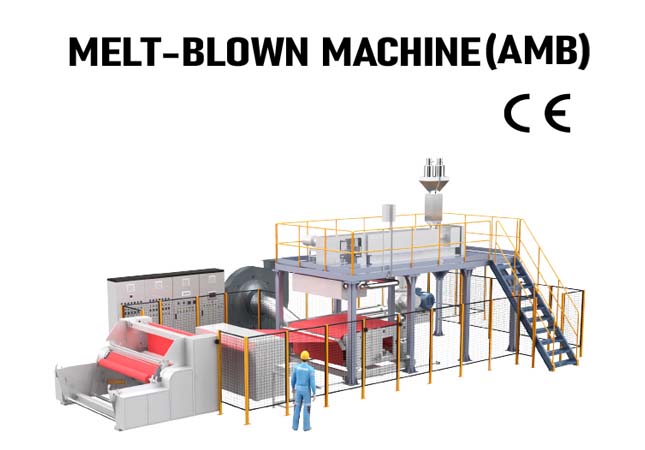A meltblown machine is a specialized manufacturing equipment that produces meltblown nonwoven fabric, a critical material used in diverse industries for its exceptional properties. This fabric is created through a process called "meltblowing," which involves melting polymer fibers, typically polypropylene, and then extruding them through tiny nozzles to form fine fibers. These fibers are then rapidly cooled and solidified, resulting in a nonwoven fabric with a unique web-like structure.

Features of the Meltblown Nonwoven Fabric
Meltblown nonwoven fabrics are a type of nonwoven material that is made through a specialized process known as meltblown technology. They are widely used in various industries and applications due to their unique properties and versatility. In this detailed introduction, we will explore the key aspects of meltblown nonwoven fabrics, including their production process, characteristics, uses, and advantages.
1. High Filtration
The microfibers in meltblown fabric are extremely small, typically ranging in diameter from 0.1 to 10 microns, which is much smaller than the fibers in conventional spunbond or needle-punched nonwoven fabrics. This fine fiber structure allows for a much higher surface area per unit weight, resulting in a fabric with excellent filtration performance. Meltblown nonwoven fabric is capable of capturing small particles, including bacteria, viruses, fine dust, and airborne pollutants, making it ideal for use in applications such as medical masks, respirators, air filters, and liquid filtration.
2. High Breathability
The fine fiber structure of meltblown fabric creates a porous network with a small pore size, allowing air to pass through easily while trapping particles. This makes meltblown fabric highly breathable and comfortable to wear in applications where breathability is important, such as in medical masks or other personal protective equipment (PPE).
3. Excellent Liquid Repellency and Absorption
The hydrophobic nature of many polymer materials used in meltblown fabric, such as polypropylene, allows it to repel liquids, making it suitable for use in applications where liquid barrier properties are required, such as in oil-absorbent mats or protective clothing. On the other hand, meltblown nonwoven fabric can also be treated with special coatings or additives to make it hydrophilic, enabling it to absorb and retain liquids, which is useful in applications such as wound dressings or absorbent pads.
Production Process of Meltblown Nonwoven Fabrics
Meltblown nonwoven fabrics are produced using a meltblown process, which involves the extrusion of a polymer melt through tiny nozzles or spinnerets. The polymer melt is then rapidly cooled by high-velocity hot air, which solidifies the melt into ultrafine fibers. These fibers are then collected on a moving conveyor belt or a drum to form a web of randomly-oriented fibers. The web is then bonded together using heat, pressure, or chemical means to create a stable fabric.
Components of the Meltblown Machine
Meltblown nonwoven machines typically consist of several key components that work together to produce high-quality meltblown fabric.
l Extrusion system: This system melts the polymer resin and pumps it through a spinneret, which contains multiple tiny nozzles. The polymer is forced through these nozzles to form fine, continuous fibers.
l Airflow system: High-speed, temperature-controlled air streams are used to blow the extruded fibers onto a moving conveyor belt or drum, creating a randomly oriented web of fibers. The airflow system also helps to cool and solidify the fibers.
l Collection system: The randomly oriented fibers are collected on a moving conveyor belt or drum and then bonded together to form a continuous sheet of meltblown fabric. This can be achieved through various methods such as hot air bonding, calendering, or other bonding techniques.
l Control system: Modern meltblown nonwoven machines are equipped with advanced control systems that monitor and adjust various process parameters, such as temperature, airflow rate, polymer melt rate, and conveyor speed, to ensure consistent and precise production of meltblown fabric.
Meltblown nonwoven machines can vary in size and configuration depending on the desired output and application of the fabric. They can be standalone machines or integrated into larger production lines. The output of meltblown nonwoven machines is typically in the form of rolls or sheets, which can be further processed into various end products, such as face masks, air filters, oil absorbent pads, and more.
SUNTECH ST-AMB Meltblown Machine
SUNTECH offers non-woven fabric slitting machines and premium meltblown machines for the production of high-quality meltblown nonwovens.
1. These machines are widely used in filtration and medical fields due to their excellent filterability and barrier properties.
2. The machines ensure strong stability and considerable productivity, allowing for easy setup and operation.
3. In industries like medical protection, strict standards for filterability are required, especially for materials used in medical and surgical face masks.
4. SUNTECH meltblown lines ensure top-class filterability for bacteria and viruses, providing worry-free quality and production stability.
5. Using SUNTECH machines can make you a reliable and sought-after supplier in the market quickly, as they help meet strict standards and produce high-quality meltblown nonwovens.
Conclusion
The meltblown machine enables the creation of fine, randomly interconnected fibers that form the dense and porous structure characteristic of meltblown fabric because of its perfect structure and variety of advantages. And the SUNTECH ST-AMB meltblown machine, which has lots of advantages, would be an ideal choice for manufacturers in the textile industry.
As a reputable textile machinery manufacturer with a rich history in automation and intelligent manufacturing technology of textile and warehousing equipment, SUNTECH Textile Machinery possesses cutting-edge core technologies that are recognized globally.
SUNTECH’s products cover the textile manufacturing and handling process of almost fabric types, in which pinking machine, non woven machine, beam truck, meltblown machine, fabric cutting machine, motorized beam trolley, beam storage, warp tying machine are the most popular machines and material handling equipment.
SUNTECH Textile Machinery leads the textile industry with our innovation and experience! Quotes and Cooperation are Highly Welcome!




